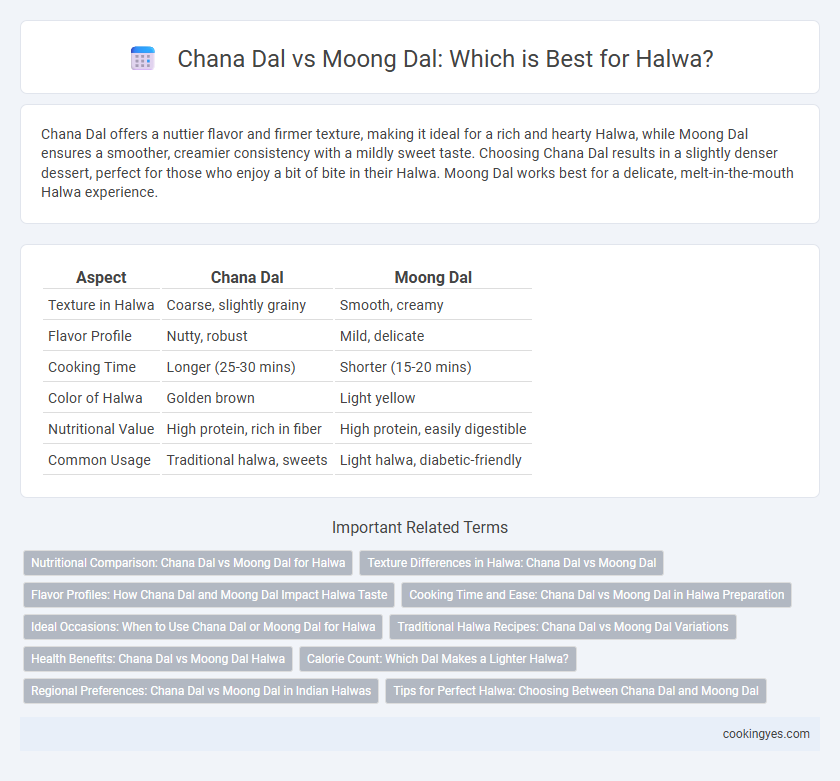Chana Dal offers a nuttier flavor and firmer texture, making it ideal for a rich and hearty Halwa, while Moong Dal ensures a smoother, creamier consistency with a mildly sweet taste. Choosing Chana Dal results in a slightly denser dessert, perfect for those who enjoy a bit of bite in their Halwa. Moong Dal works best for a delicate, melt-in-the-mouth Halwa experience.
Table of Comparison
| Aspect | Chana Dal | Moong Dal |
|---|---|---|
| Texture in Halwa | Coarse, slightly grainy | Smooth, creamy |
| Flavor Profile | Nutty, robust | Mild, delicate |
| Cooking Time | Longer (25-30 mins) | Shorter (15-20 mins) |
| Color of Halwa | Golden brown | Light yellow |
| Nutritional Value | High protein, rich in fiber | High protein, easily digestible |
| Common Usage | Traditional halwa, sweets | Light halwa, diabetic-friendly |
Nutritional Comparison: Chana Dal vs Moong Dal for Halwa
Chana Dal and Moong Dal differ significantly in their nutritional profiles, influencing their suitability for halwa recipes. Chana Dal is richer in protein and dietary fiber, offering approximately 21 grams of protein and 12 grams of fiber per 100 grams, which supports sustained energy release and digestive health. Moong Dal, containing around 24 grams of protein and 16 grams of fiber per 100 grams, provides higher protein and fiber content, making it slightly more nutritious and beneficial for those seeking enhanced nutrient density in halwa.
Texture Differences in Halwa: Chana Dal vs Moong Dal
Chana dal halwa features a coarser, grainier texture due to its larger and firmer split chickpeas, providing a slightly chewy bite that balances sweetness. Moong dal halwa yields a smoother, creamier consistency because the moong dal breaks down more easily during cooking, resulting in a delicate, melt-in-the-mouth experience. The textural contrast makes chana dal halwa heartier, while moong dal halwa offers a silkier dessert option.
Flavor Profiles: How Chana Dal and Moong Dal Impact Halwa Taste
Chana Dal imparts a rich, nutty flavor and a hearty texture to halwa, creating a robust and rustic taste profile that stands out in traditional recipes. Moong Dal, on the other hand, offers a lighter, subtly sweet flavor with a smoother, delicate texture, making the halwa softer and more melt-in-the-mouth. The choice between Chana Dal and Moong Dal significantly influences the halwa's overall taste and mouthfeel, with Chana Dal providing depth and earthiness, while Moong Dal lends a mild sweetness and silky consistency.
Cooking Time and Ease: Chana Dal vs Moong Dal in Halwa Preparation
Chana dal requires a longer cooking time compared to moong dal, often needing to soak and boil for 30-40 minutes to soften adequately for halwa. Moong dal cooks faster, usually within 15-20 minutes, making it a more convenient choice for quicker halwa preparation. The ease of cooking moong dal allows for a smoother, creamier consistency in halwa without prolonged soaking or multiple boiling stages.
Ideal Occasions: When to Use Chana Dal or Moong Dal for Halwa
Chana Dal is ideal for festive occasions and traditional Indian desserts where a richer, nutty flavor and coarser texture are preferred, creating a hearty halwa. Moong Dal suits lighter, everyday sweets and health-conscious recipes due to its delicate taste and smooth consistency, making it perfect for family gatherings or casual celebrations. Choosing between Chana Dal and Moong Dal depends on the desired texture and flavor intensity, aligning with the event's cultural significance and dietary preferences.
Traditional Halwa Recipes: Chana Dal vs Moong Dal Variations
Chana Dal halwa delivers a rich and nutty flavor with a dense texture, traditionally favored in North Indian sweets for its robust taste and satisfying bite. Moong Dal halwa, lighter and more buttery, offers a smoother consistency and subtle sweetness, making it a popular choice in Rajasthani and Punjabi cuisine. Both variations utilize ghee and cardamom, but Chana Dal requires longer cooking to soften the larger pulses, while Moong Dal's quick-cooking properties result in a faster, silkier halwa preparation.
Health Benefits: Chana Dal vs Moong Dal Halwa
Chana dal halwa offers higher protein and fiber content, promoting better digestion and sustained energy release compared to moong dal. Moong dal halwa is lighter and easier to digest, rich in antioxidants and essential vitamins that support heart health and weight management. Choosing between chana dal and moong dal for halwa depends on health goals, with chana dal providing more complex nutrients and moong dal offering a gentle option for sensitive stomachs.
Calorie Count: Which Dal Makes a Lighter Halwa?
Chana Dal halwa contains approximately 120 calories per 100 grams, making it slightly higher in calories due to its denser carbohydrate and protein content. Moong Dal halwa offers around 110 calories per 100 grams, resulting in a lighter dessert option with quicker digestibility and more water content. Choosing moong dal for halwa benefits calorie-conscious individuals seeking a lighter, nutrient-rich sweet treat.
Regional Preferences: Chana Dal vs Moong Dal in Indian Halwas
Chana Dal and Moong Dal are both essential pulses used in Indian halwas, with regional preferences shaping their usage. Chana Dal is predominantly favored in North Indian halwas such as Besan Halwa for its robust, nutty flavor and coarse texture. In contrast, Moong Dal, preferred in South Indian and Bengali halwas like Moong Dal Halwa, offers a lighter, creamier consistency, making it ideal for delicate, melt-in-the-mouth desserts.
Tips for Perfect Halwa: Choosing Between Chana Dal and Moong Dal
For perfect halwa, choosing between chana dal and moong dal depends on texture and flavor preference; chana dal offers a nutty, robust taste and firmer texture, ideal for a rich, coarse halwa, while moong dal provides a smoother, creamier consistency with a mildly sweet flavor, perfect for delicate, melt-in-mouth desserts. Soaking the dal adequately and roasting it lightly before grinding enhances flavor and prevents lumping during cooking. Consistent stirring and slow cooking ensure the halwa attains the ideal thick, glossy finish whether using chana dal or moong dal.
Chana Dal vs Moong Dal for Halwa Infographic

 cookingyes.com
cookingyes.com